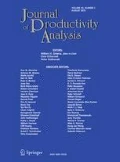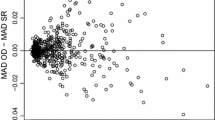Abstract
The introduction of directional distance functions has given researchers an alternative to Shephard distance functions. In this paper we conduct a Monte Carlo study to investigate the performance of distance functions as an approximation for models of technology. Our results indicate that quadratic representations of technology have better approximation properties than translog parameterizations.





Similar content being viewed by others
Notes
Note that the generalized Leontief function does not belong to the family of generalized quadratic functions and is therefore not considered here.
There are two reasons why the functions that are nonlinear in parameters have been excluded from our analysis. First, linear-in-parameters specifications are the most common functional forms used in economics. Second, to our knowledge the functional equations that are associated with nonlinear-in-parameters functions that satisfy homogeneity or translation have not yet been solved.
The authors assume I = 2.
The authors assume that α0 = 0 in (6).
These two functions were suggested for the parameterization of the directional distance function by Chambers (1998) who took \( \lambda = {1 \mathord{\left/{\vphantom {1 2}} \right. \kern-\nulldelimiterspace} 2} \) in (10).
During the initial stages of our analysis we experimented with a number of other forms of the true technology, including polynomials of orders both higher and lower than four. The outcomes of these trials were always in line with ones we summarize here for a more limited number of true models. Hence, the decision to include only a small number of true technologies does not result in a significant loss of generality and it allow us to keep the simulation results easily interpretable—a welcomed characteristic in any Monte Carlo study.
As with the polynomial technologies, a number of alternative specifications for true translog models were considered at the initial stages of the study. Since the quality of approximation provided by the quadratic directional distance function versus the translog Shephard distance function was very similar across various true technologies, we decided to summarize the results from just three of them.
Linear programming methodology facilitates a straightforward modeling of all of the functions’ properties, such as representation, monotonicity, as well as homogeneity (in the case of the Shephard distance function), and translation (in the case of the directional distance function). See Färe et al. (2005) or Vardanyan and Noh (2006) for a more detailed analysis of the computation procedures.
We have also considered models that include interaction terms between y 1 and the inputs in the expressions representing true technology. Since all simulation results remained qualitatively unaffected, we imposed separability between inputs and outputs in our data generating process (DGP). We note that such assumption is not incorporated in equations (15) and (16), reflecting the potential ignorance about the true DGP and our desire to evaluate the performance of generalized quadratic specifications.
One can alternatively use y 2 to simulate the optimal quantity of the first output.
Note that the methods we use to add technical inefficiency in (12) and (14) ignore different scale effects entailed by these directional vectors. For a detailed discussion of scaling using directional vectors see Färe and Grosskopf (2004).
We do not report any of the benchmark values unless the fraction of converging simulations is greater than one.
Note that the benchmark values associated with the Shephard distance function are not reported for any of our type-A models due to the wrong (convex) curvature of the corresponding frontier estimates and the failure of the estimation algorithms to converge after the imposition of appropriate curvature constraints.
There are a few instances in quadratic models when the average benchmark value increased as the sample size went up from 100 to 500 to 1,000 observations. The rate of this increase was the highest in Model Q3A and Model Q3B, i.e. the two frontiers with the most curvature.
Note that these maxima are obtained across three quadratic parameterizations, each of which corresponds to a specific value of the directional vector, and that both of the maxima reported are from parameterizations that assume g = (5,1).
References
Aigner DJ, Chu S-F (1968) On estimating the industry production function. Am Econ Rev 58:826–839
Atkinson SE, Färe R, Primont D (2003a) Stochastic estimation of firm inefficiency using distance functions. South Econ J 69(3):596–611
Atkinson SE, Cornwell C, Honerkamp O (2003b) Measuring and decomposing productivity change: stochastic distance function estimation versus data envelopment analysis. J Bus Econ Stat 21(3):284–294
Chambers RG (1998) Input and output indicators. In: Färe R, Grosskopf S, Russell RR (eds) Index numbers: essays in honour of Sten Malmquist. Kluwer Academic Publishers, Boston
Chambers RG, Chung Y, Färe R (1998) Profit, distance functions and Nerlovian efficiency. J Optim Theory Appl 98:351–364
Christensen LR, Jorgenson DW, Lau LJ (1971) Conjugate duality and the transcendental logarithmic production function. Econometrica 39:255–256
Diewert WE (1971) An application of the shephard duality theorem: a generalized leontief production function. J Polit Econ 79:481–507
Diewert WE (2002) The quadratic approximation lemma and decomposition of superlative indexes. J Econ Soc Meas 28:63–88
Färe R, Grosskopf S (2004) New directions: efficiency and productivity. Kluwer Academic Publishers, Boston
Färe R, Primont D (1995) Multi-output production and duality: theory and applications. Kluwer Academic Publishers, Boston
Färe R, Sung KJ (1986) On second-order Taylor’s series approximation and linear homogeneity. Aequationes Mathematicae 30:180–186
Färe, Rolf and Anders Lundberg. (2005). “Parameterizing the Shortage (Directional Distance) Function.” Oregon State University Working Paper
Färe R, Grosskopf S, Hayes Kathy, Margaritis D (2008) Estimating demand with distance functions: parameterization in the primal and dual. J Econom 147:266–274
Guilkey DK, Knox Lovell CA, Sickles RC (1983) A comparison of the performance of three flexible functional forms. Int Econ Rev 24:591–616
Luenberger DG (1992) Benefit functions and duality. J Math Econ 21:461–481
Morishima M (1967) A few suggestions on the theory of elasticity. Keizai Hyoron (Econ Rev) 16:144–150
Perroni C, Rutherford TF (1995) Regular flexibility of nested CES functions. Eur Econ Rev 39:335–343
Perroni C, Rutherford TF (1998) A comparison of the performance of flexible functional forms for use in applied general equilibrium analysis. Comput Econ 11:245–263
Shephard RW (1953) Cost and production functions. Princeton University Press, Princeton
Shephard RW (1970) Theory of cost and production functions. Princeton University Press, Princeton
Vardanyan M, Noh DW (2006) Approximating the cost of pollution abatement via alternative specifications of a multi-output production technology: a case of the U.S. electric utility industry. J Environ Manage 80:177–190
Author information
Authors and Affiliations
Corresponding author
Rights and permissions
About this article
Cite this article
Färe, R., Martins-Filho, C. & Vardanyan, M. On functional form representation of multi-output production technologies. J Prod Anal 33, 81–96 (2010). https://doi.org/10.1007/s11123-009-0164-4
Published:
Issue Date:
DOI: https://doi.org/10.1007/s11123-009-0164-4




